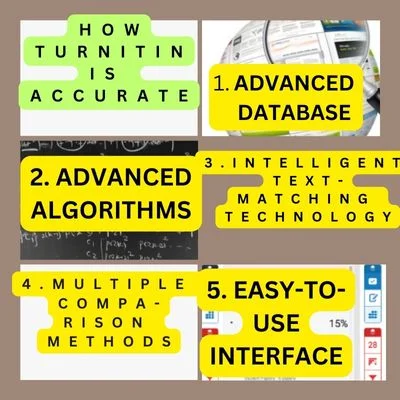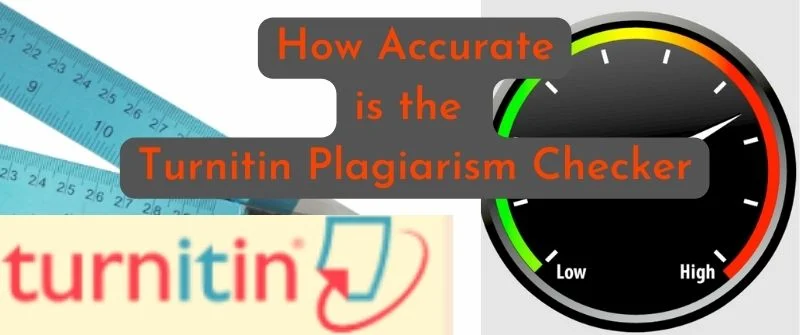Turnitin is a popular plagiarism detection software that checks submitted academic papers against a vast database of sources and flags potential instances of plagiarism.
While it is a popular tool universities and instructors use to promote academic integrity, there have been questions about its effectiveness and accuracy.
This response will look closer at Turnitin and evaluate its effectiveness in identifying plagiarism.
Is Turnitin Plagiarism Checker Accurate?
Turnitin is a great tool for promoting academic integrity and identifying potential instances of plagiarism. However, using it thoughtfully and with other strategies is important to ensure accuracy and promote ethical academic practices.

Turnitin is a reliable and effective plagiarism checker. It uses advanced algorithms and vast academic sources databases to identify potential plagiarism instances, including text matching, paraphrasing, and incorrect citation.
However, Turnitin is not infallible and can sometimes produce false positives or miss instances of plagiarism.
For example, it may be unable to detect plagiarism from sources not included in its database or identify unintentional plagiarism.
Additionally, it is only as accurate as the sources included in its database. It cannot detect instances of plagiarism from unpublished works or offline sources.
Use it in conjunction with other tools to maximize the accuracy of Turnitin and strategies to promote academic integrity, like educating students on proper citation practices and providing clear guidelines and expectations for assignments.
How Accurate is Turnitin plagiarism Checker?
Turnitin is a highly accurate plagiarism checker that is popular in academic institutions around the world. Here are some reasons why:
- Extensive Database: Turnitin has an extensive database of over 70 billion web pages, articles, and journals for comparison. Even if you reword or paraphrase your content, this large database ensures that it can identify instances of plagiarism.
- Advanced Algorithms: Turnitin uses advanced algorithms to analyze the submitted work and compare it with the content in its database. These algorithms can flag patterns and similarities in the text that may indicate plagiarism.
- Intelligent Text-Matching: Turnitin uses intelligent text-matching technology to detect matches between the submitted work and other documents, even if the text has been modified or altered.
- Multiple Comparison Methods: Turnitin uses multiple comparison methods to check for plagiarism, including word-for-word matching, string matching, and contextual analysis. That ensures that it can identify plagiarism in various forms and catch even the most sophisticated attempts at cheating.
- Easy-to-Use Interface: Turnitin’s user-friendly interface makes it easy for instructors and students. The tool generates a report highlighting potential plagiarism instances and links to the original source material.
- Constant Updates: Turnitin is continually updated to ensure that it is up-to-date with the latest trends in academic writing and plagiarism. This means it can identify new forms of plagiarism and remain an accurate and reliable tool for detecting cheating.

Overall, Turnitin is a reliable tool for detecting plagiarism and is very effective in scanning for similarity.
It accuracy depends on various factors like the quality of the database, the type of plagiarism, and the expertise of the person using it.
Professors need to use Turnitin in conjunction with their own knowledge and expertise to ensure that academic integrity is put in place.
Students also can use a Turnitin report to remove similarities from their papers and get a more acceptable plagiarism percentage on the final paper.
Practical test on the Accuracy of Turnitin
Every time you use Turnitin, it is critical that you understand how this software interprets results. For our case, we uploaded three papers and compared the results as follows:
- Paper 1 had a similarity score of 4%
- Paper 2- had a similarity score of 16%
- Paper 3 has a similarity score of 34%
The similarity score provided by Turnitin is expressed as a percentage and represents the percentage of text in the submitted document that matches existing sources.
Comparison of the Three Papers
Paper 1
One of the primary factors that affect Turnitin’s accuracy in Paper 1 is the quality of the sources it uses.
Turnitin has a vast database of sources, including academic journals, publications, and websites.
However, if the sources need to be updated, complete, and relevant to the subject matter, Turnitin may not be able to detect instances of plagiarism effectively.
Therefore, the quality and relevance of the sources are essential to ensure accurate results.
Paper 2
The complexity of the text being compared affected Turnitin’s accuracy on Paper 2.
The text being compared is too short or too simple. For that reason, Turnitin may not be able to detect instances of plagiarism effectively.
Paper 3
The instructor’s settings can also affect Turnitin’s accuracy in Paper 3. The instructor sets the software to be too strict, leading to Turnitin producing more false positives.
Alternatively, the student who wrote the essay did not eliminate cases of plagiarism before submission.
In conclusion, the accuracy of Turnitin depends on the quality of sources, the complexity of the text, and the settings used by the instructor.
By considering these factors, educators and academic institutions can ensure the accurate detection of plagiarism.
Check out a few hacks to use Turnitin for free if you want to try it for yourself.
